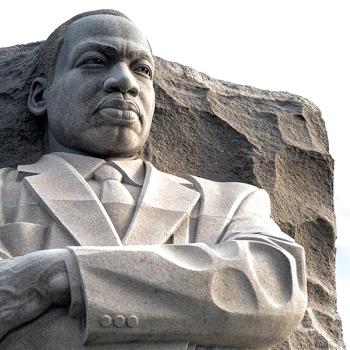 January 16, 2011
January 16, 2011
John the Baptist Introduces His Disciples to Jesus
Lectionary Reflections on John 1:29-34
I have a friend Susan who says her husband always remembers a face but seldom a name. So when they go to a social event and approach someone whose name he should know but doesn't remember, they have devised a social strategy that works for them. He places his hand gently in the small of her back and guides her toward the person with these words "This is my wife, Susan." Anyone with any manners at all is going to respond by giving their own name. Not many people are going to just stare at Susan until it becomes awkwardly clear that her husband has no recollection of their name. I'll bet that any of you reading this would respond by putting out your hand, shaking her hand, and saying, with a gracious smile, "It's nice to meet you, Susan. My name is ___________."
Our text for this morning has John introducing Jesus to some of his (John's) disciples, with the description: "Look, here is the Lamb of God!" This is a "revelation formula" John likes to use when recounting people's interactions with Jesus in his gospel. In 1:49, Nathanael introduces Jesus to his view of him: "Rabbi, you are the Son of God!" In 19:24-27 Jesus himself, dying on the cross, introduces his mother to the disciple whom he loved and vice versa. "Woman, here is your son. . . . Here is your mother."
This formula shows up in the Old Testament when a messenger of God (or God) sees a person and says "Look!" This is followed by a description of that person's identity and mission. In 1 Samuel 19:17, for example, when Samuel saw Saul, God says to him "Look! Here is the man . . . who shall rule over my people." (Raymond E. Brown, The Anchor Bible Commentary on John, p. 58)
Do you notice how, in this passage, being introduced to Jesus prompts the disciples to figure out their own true identity, or, more precisely, to be guided toward it by Jesus? It's an odd scenario, really. Not like anything that would happen in ordinary social gatherings when people are introduced to other people. John introduces Jesus to two of his own disciples. It sounds like he may almost have been talking to himself and they overheard. They followed Jesus. When he turns around and asks, "What are you looking for?" he is asking them to identify themselves. To say something like: "We are two people looking for meaning and purpose in our lives and we think you may be it." I think the reason they don't say that is because they are not sure who they are or even that they are looking for something. So instead of answering, they counter Jesus' question with another question: "Where are you staying?"
And they stay with him all day. At some time during the day, Andrew, one of the two, goes and gets his brother Simon. He introduces Jesus to his brother from a distance with the description "This is our Messiah, Jesus." In the subsequent face-to-face encounter with Jesus, Jesus gives Simon a new identity: "You are Simon son of John. You are to be called Cephas" (1:42).
In terms of my friend Susan's anecdote, John the Baptist is introducing us to Jesus saying, "This is the Lamb of God, Jesus." It is now up to us to put out our hand and say who we are and allow him to shape our identity in the year to come.
I wonder if this message would have much meaning for someone new to the faith. If I haven't heard much about Jesus, if I don't really know who he is and what he does, then it means little to me to be told that his identity is now going to shape mine. Why would he be my choice among so many other options?
I need to have an answer to the question, "Who is the Lamb of God?"
John the evangelist would have made a superlative screen play writer. He is the master of crafting brief scenes that include whole Christologies! Here, in this scene in which John the Baptist introduces us to Jesus as the Lamb of God, John the evangelist manages to convey that this Lamb of God is pre-existent (1:30-31), the one upon whom the Spirit descends and rests (1:32-35), and the chosen one (1:34). I'm thinking that, since my identity is bound to be shaped by somebody and something in 2011, I want it to be shaped by this man who is walking by us right now: the Son of God, God's unique instrument, the Messiah and the Servant of the Lord.
"Look! Here is the Lamb of God!" This introduction conveys three key aspects of Jesus' identity. He is the apocalyptic lamb who destroys evil. He is the Suffering Servant willing to give his life for the redemption of his people. He is the paschal lamb who takes away our sins and leads us from bondage to liberation.
The lamb is the apocalyptic lamb. Jewish writings about the end of times included a figure of a conquering lamb who will destroy evil in the world (Brown, p. 59). Raymond Brown suggests that John the Baptist hailed Jesus as the lamb of Jewish apocalyptic expectation who was to be raised up by God to destroy evil in the world. This picture fits John's prediction that Jesus would divide the wheat from the chaff (Mt. 4:23; Lk. 3: 17) and it is similar to Revelation 17:14 (Brown, p. 60.)





